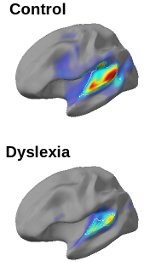Dyslexia & Reading Disorders
Our Research
Dyslexia & Reading Disorders

We want to understand what changes occur in the brain during the acquisition of language and literacy, and how these processes differ for individuals who struggle to develop typical reading or language abilities. Between 5-15% of children struggle to develop typical reading abilities, the hallmark of a disorder known as developmental dyslexia. Scientific research, including work from our laboratory, has strongly suggested that the underlying difficulty in dyslexia stems from a difference in how these individuals’ brains represent and process the sounds of language.
Our research attempts to identify what exactly the source of this difference is. Is there something distinct about the processes underlying either rapid or long-term auditory plasticity in the brains of individuals with dyslexia? If the source of reading difficulty is in representing and processing the sounds of language, why do individuals with dyslexia struggle to learn to read, but not struggle to learn to understand speech? Using advanced brain imaging and neuromodulation techniques, can we develop quantitative biomarkers for the diagnosis or remediation of developmental communication disorders like dyslexia?
News and Popular Science
- Time: “Why dyslexia is more than a reading disorder“
- The Boston Globe: “Roots of dyslexia may be deeper than previously thought“
- Inside Sargent: “Dyslexia Paradox”
- The New York Times: “Study sheds light on auditory role in dyslexia“
- National Science Foundation: “Dissecting dyslexia: Linking reading to voice recognition“
Major Publications
- Perrachione, T.K., Del Tufo, S.N., Winter, R., Murtagh, J., Cyr, A., Chang, P., Halverson, K., Ghosh, S.S., Christodoulou, J.A. & Gabrieli, J.D.E. (2016). “Dysfunction of rapid neural adaptation in dyslexia.” Neuron, 92, 1383-1397. | Publisher | PDF
- Perrachione, T.K., Del Tufo, S.N., & Gabrieli, J.D.E. (2011). “Human voice recognition depends on language ability.” Science, 333, 595. | Publisher | PubMed